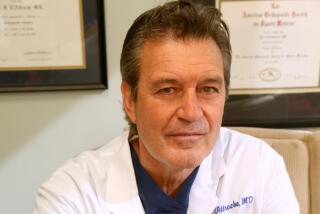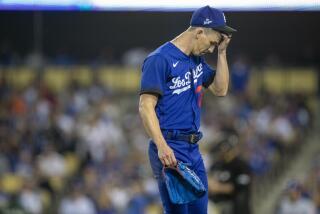Pitching for Progress
- Share via
It was a pitch no young baseball player could resist.
Come stand on the same pitcher’s mound that Orel Hershiser, Tommy John and Fernando Valenzuela have used and let researchers helping major leaguers avoid arm injuries take a look at your throwing style.
And, oh yeah. We’ll give you a slick, slow-motion videotape that shows your own hurling technique from side, front and top views. And we’ll clock your pitching speed with the same radar gun that professional baseball coaches use.
That’s why Little Leaguers and high school baseball players were lined up Wednesday at Centinela Hospital Medical Center, gloves tucked under their arms and visions of big league careers dancing in their heads.
The Inglewood hospital’s biomechanics lab is about a third of the way through a 10-year study of pitching injuries that has been commissioned by Major League baseball. And research so far suggests that many professional pitchers’ arm problems may be the result of their poor pitching technique as youths.
Pitchers from 23 National League and American League teams have taken part so far in the research.
Outfitted with special infrared reflectors that are glued to their arms, shoulders and legs, the pitchers throw baseballs into a net set up in one of the lab’s doorways. Surrounding them are infrared cameras that record the reflectors’ movement, feeding the information into a computer that determines which part of the body is helping to propel the ball.
In the second part of the test, high-speed cameras filming at 450 frames per second capture the pitcher’s movement from three angles.
The study has indicated that most adult pitchers’ power comes from shoulder and trunk rotation, which transfers energy from the torso and legs into each pitch.
But researchers think young baseball players lack that sort of leg and trunk strength. And if they rely solely on their arms for ball speed, that could cause arm damage that could haunt them in their adult careers, according to Karen Berger, manager of the biomechanics lab.
“Most major leaguers started pitching at age 6 or 7. We’re trying to determine if there are specific things that they might have done that would cause their injuries,” she said.
Berger put out a call for 100 volunteers between ages 9 and 17 to youth baseball leagues in communities around the hospital. So many players responded that the list swelled to 120 before lab workers stopped taking sign-ups.
Twelve-year-old Michael Daniel of Gardena came because he wanted to find out how fast he throws. He was delighted when one of his pitches was clocked at 58 mph.
His father, computer analyst Jerry Daniel, said he was more interested in seeing the slow-motion tape and the graph printouts that come from the infrared monitors.
“If you’re throwing the wrong way at 9 or 10 and it doesn’t get corrected until you’re in college, you’ve done nine or 10 years of damage to yourself,” Daniel said.
Varsity team pitchers brought to the lab by Hawthorne High baseball coach Jeff Hines pledged to mend their ways if the tests show they may be prematurely wearing out their arms.
“I could change,” said Sergio Reyes, 16, of Inglewood, who was clocked pitching 76 mph.
That kind of speed had Berger thinking about her own future.
“It would be a wonderful thing to have someone we’ve tested here go on to be a major leaguer so we can do follow-up studies,” she said. “We’ve had several kids pitching in the high 70s. We have some really good players in here.”
Hospital officials said the youthful players will receive their videotapes a week from today when they are invited back to the hospital for a meeting with Dodger outfielder Todd Hollandsworth, the 1996 National League Rookie of the Year.
Professional players, meantime, will get a preview of what researchers have discovered in February at a seminar planned for the Dodger training camp in Florida.
More to Read
Go beyond the scoreboard
Get the latest on L.A.'s teams in the daily Sports Report newsletter.
You may occasionally receive promotional content from the Los Angeles Times.











